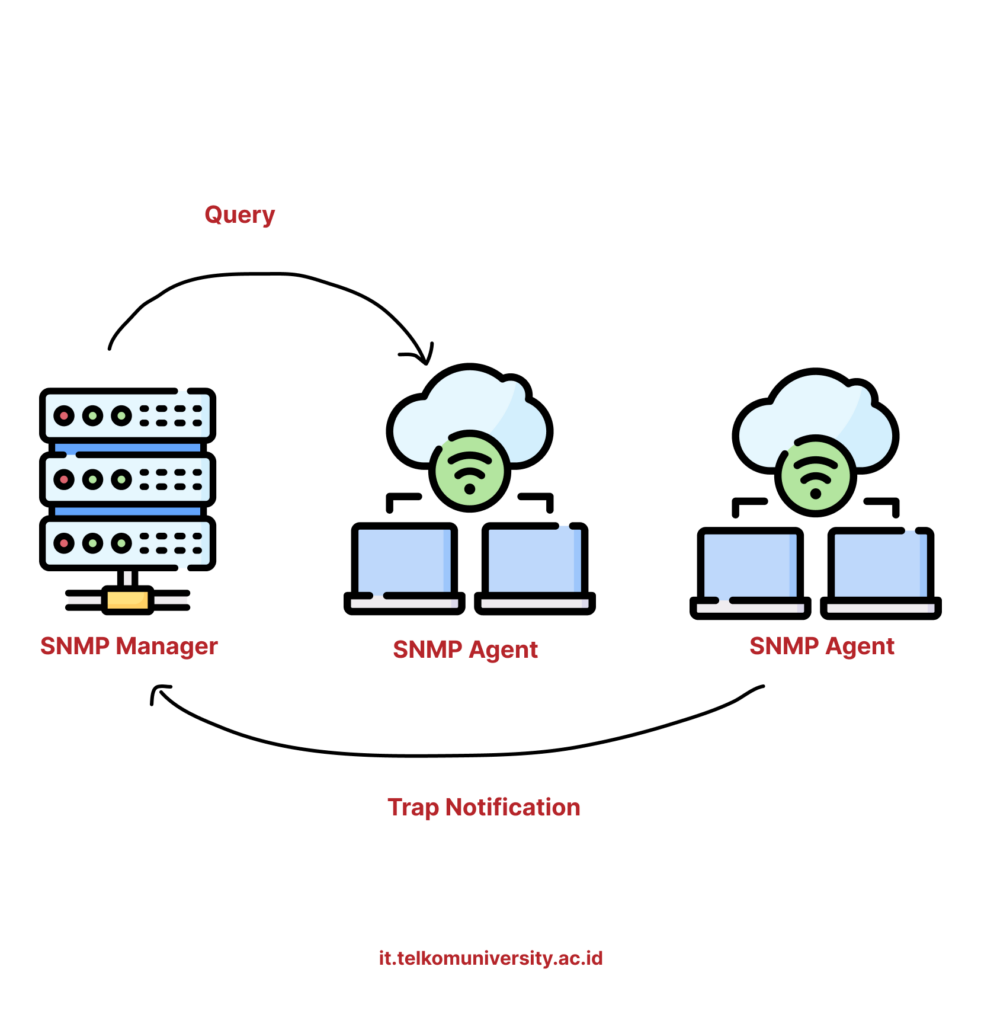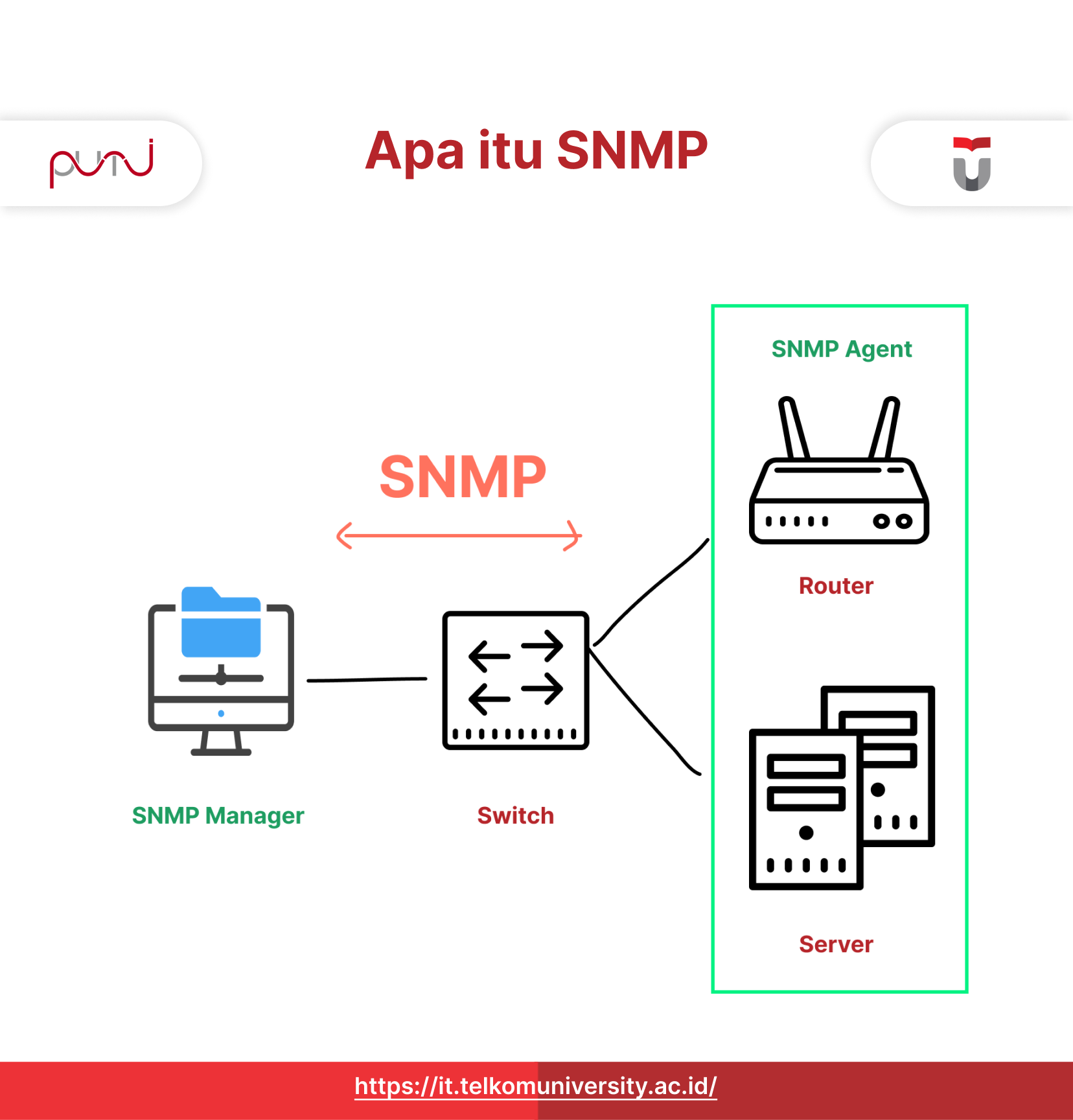SNMP protocol, a protocol in networking that helps manage and monitor various hardware devices such as routers, switches, servers, and other network devices. This protocol allows network administrators to gather information about the state, performance and usage of network devices, as well as remotely manage and control these devices.
SNMP is an important protocol in network management, as it allows administrators to monitor network performance, identify problems, manage network devices, and respond to changes or events that occur on the network.
What is SNMP

SNMP (Simple Network Management Protocol) is a network protocol used to monitor network changes and determine the status of devices such as routers, switches, servers, and other network-connected devices. This protocol enables network administrators to collect information about the performance, state, and usage of network devices, as well as remotely manage and control those devices. Every device on a computer network can be queried in real time using SNMP over TCP or UDP.
SNMP is essential in network management because it allows administrators to monitor network performance, identify problems, manage network devices, and respond to changes or events on the network. The information collected includes device status, resource usage, network traffic, performance statistics, and more.
SNMP has become a widely used industry standard and is supported by various network devices and network management software. The latest version of this protocol is SNMPv3, which offers enhanced security features through encryption and authentication.
How SNMP Works
The increasing sophistication of technology and platforms requires capable IT infrastructure management. Internet activities such as data transfer, browsing, and downloading require servers to operate optimally, as well as the protocols that support these activities. SNMP plays a role in network communication by collecting information related to device activity. Some SNMP tasks include tracking the number of bytes, packets, and errors sent and received by a router, measuring the connection speed between devices, and recording the number of clicks received by a web server.
SNMP works by sending messages called Protocol Data Units (PDUs) to devices on the network that support SNMP. These messages include SNMP Get-Requests. With these requests, network administrators can monitor almost any data value they specify. All the information tracked by SNMP can then be saved or displayed according to the network administrator’s preferences.
SNMP Functions
The functions of SNMP (Simple Network Management Protocol) are as follows:
Monitoring and Data Collection
SNMP allows network administrators to monitor and collect data on the performance, state, and usage of network devices. This includes information such as network traffic, resource usage, device status, and performance statistics. This data can be used to analyze and monitor the network, identify problems, and make informed decisions to optimize network performance.
Configuration and Device Management
SNMP allows administrators to remotely manage network devices. Using this protocol, administrators can send configuration commands to devices, change settings, and monitor changes. This allows for efficient administration and centralized network management.
Notifications and Alerts
SNMP can also be used to send notifications and alerts to network administrators about important events or conditions. For example, SNMP can send notifications when an error occurs on a network device, a capacity limit is reached, or a security threat is detected. This allows administrators to respond quickly and take necessary actions to maintain network stability.
Capacity Management and Network Planning
By monitoring and collecting data provided by SNMP, administrators can perform effective capacity management and network planning. Information on resource usage, performance, and network traffic can be used to estimate capacity requirements, identify bottlenecks, and plan necessary network upgrades or optimizations.
Interoperability
SNMP is an industry-standard protocol that supports a wide range of network devices and operating systems. It enables easy integration and interoperability between network devices from different vendors and across different network environments.
With these functions, SNMP has become an important tool in network management, helping administrators manage, monitor, and optimize networks more efficiently.
Also Read : What is ICMP
Advantages and Disadvantages of SNMP
Advantages of SNMP
Industry Standard
SNMP is an industry standard that is widely used and supported by various network devices and network management software. It enables good interoperability between network devices from different vendors and across different network environments.
Scalability
SNMP is designed to support growing and complex networks. This protocol can be used to manage networks consisting of thousands of devices, including routers, switches, servers, and other network devices.
Monitoring and Data Collection
SNMP enables the collection of data about the performance, state, and usage of network devices. This information can be used to monitor network performance, identify problems, and make informed decisions to optimize the network.
Disadvantages of SNMP
Limited Security
Early versions of SNMP, such as SNMPv1 and SNMPv2, had limited security features. Information sent via SNMP could be intercepted and read by unauthorized parties. This posed a security risk if sensitive information, such as passwords or network configurations, was exposed.
Vulnerability to Attacks
SNMP is vulnerable to attacks such as spoofing, denial-of-service (DoS), or brute-force attacks. If not implemented properly or protected with additional security protocols, SNMP can become a weak point in the network that can be exploited by attackers.
Not Ideal for Extremely Large Networks
SNMP may not be suitable for extremely large or complex networks with thousands of devices. Overuse or excessively frequent data collection via SNMP can overload the network and result in significant overhead.
Also Read : What is FTP
Types of SNMP
There are several commonly used SNMP versions:
SNMPv1 (Simple Network Management Protocol version 1)
SNMPv1 is the initial version of the SNMP protocol. It provides basic functions for network management, such as data collection and device configuration. However, SNMPv1 security is limited, as it lacks strong encryption or authentication support.
SNMPv2c (Simple Network Management Protocol version 2c)
SNMPv2c is a variant of SNMPv2 that retains most of the functionality of SNMPv2 but omits some of the improvements and security features of SNMPv3. It is still used in some implementations that do not require high security.
SNMPv3 (Simple Network Management Protocol version 3)
SNMPv3 is the latest and most secure version of the SNMP protocol. It provides enhanced security features, including encryption, strong authentication, and data integrity. SNMPv3 also supports more granular user management with role-based access rights.
In addition, there are other related technologies, such as:
RMON (Remote Monitoring)
RMON is an SNMP extension that provides more advanced network monitoring functions. It enables more detailed monitoring and data collection on network traffic, statistics, and device behavior.
The choice of SNMP version depends on the network management needs, the desired level of security, and the capabilities of the supported network devices. SNMPv3 is the preferred choice when security is a top priority.
5 Basic SNMP Commands You Must Know
SNMP uses basic commands to communicate between SNMP managers (NMS – Network Management System) and SNMP agents. The NMS is an application that monitors and controls network devices via SNMP. The NMS sends commands to an SNMP agent to retrieve information or set network device parameters. SNMP agents reside on network devices (such as switches, routers, or servers) and monitor and manage the device. The SNMP agent receives commands from the NMS manager and sends the requested information or performs the commanded action. Here are five basic commands:
Trap
The SNMPTRAP command is commonly used by devices to send alerts. This command takes the form of an asynchronous message sent by the agent to the manager when there is something to report. For example, a storage device might send an SNMPTRAP to the manager when access to a drive is lost. Other examples include power-on notifications or high-traffic notifications. SNMP managers do not have to passively wait for agents to send messages. Managers can proactively request data to ensure the device is functioning properly.
Get
The SNMPGET command retrieves one or more values from the MIB (Management Information Base).
Get Next
The GETNEXT command retrieves the next OID (Object Identifier) value in the MIB.
Get Response
The GETRESPONSE command is used by the SNMP agent to send back the value of the action requested by the SNMP manager. If the SNMP manager requests data from the agent with a GET message, then the agent sends back a GETRESPONSE.
Set
The SNMPSET command is used by the SNMP manager to instruct SNMP agents to perform an action. Some agents control changeable settings, such as relay outputs.
These five basic commands are fundamental to communication in the SNMP protocol, enabling the exchange of information and the management of network devices.
Conclusion
SNMP (Simple Network Management Protocol) is an important networking protocol used to manage and monitor network devices such as routers, switches, and servers. This protocol helps network administrators gather information about the performance, state, and usage of network devices, and remotely control them. With SNMP, administrators can monitor network performance, identify problems, and respond quickly to events.
Improve your network management skills by learning SNMP at Private Campus in Bandung. Master essential protocols to manage and monitor network devices, and optimize your IT performance.
References
https://www.fortra.com/resources/articles/snmp-basics-what-it-and-how-it-works
Author : Hassan Rizky Putra Sailellah | Editor : Meilina Eka Ayuningtyas
Tags : Kampus Swasta Terbaik di Indonesia | Kampus Swasta di Jakarta | Kampus Swasta di Bandung | Kampus Swasta Terbaik | Kampus Swasta di Surabaya | Universitas Swasta Terbaik di Indonesia | Universitas Swasta di Jakarta | Universitas Swasta di Bandung | Universitas Swasta di Surabaya | Universitas Swasta Terbaik di Jakarta | PTS Terbaik di Indonesia | Universitas Swasta Terbaik | Universitas Terbaik di Bandung








